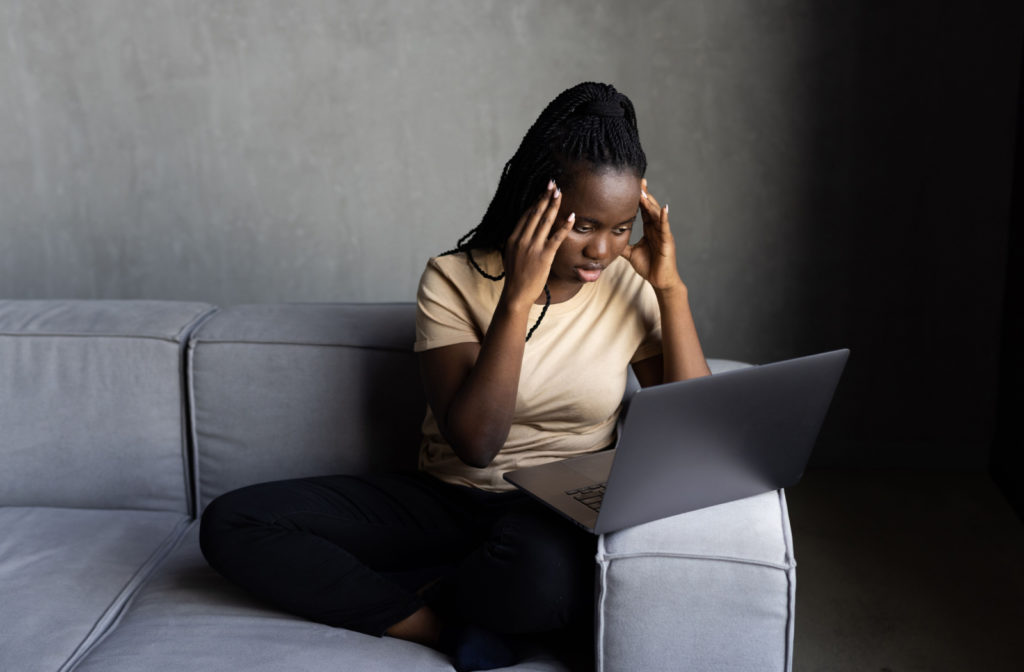Let’s talk about sitting too close to the computer monitor. You might’ve heard that it can damage your eyes.
When sitting too close to the screen or holding a digital device closer than we would a book, it could lead to temporary issues such as the moisture layer on the surface of the eyes drying out, poor circulation, muscle stiffness, and reduced flexibility. However, according to the American Academy of Ophthalmology, staring at your computer screen for long periods won’t cause permanent eye damage.
Surprised? It’s true. It doesn’t mean there are no problems at all, though. While they aren’t permanent, it’s still important to take steps to reduce the side effects of sitting too closely to your monitor.
If you’re worried about digital eye strain, or any other side effects you might be experiencing, a good place to turn is your eye doctor at Total Vision Del Mar–book in for an eye exam and review!
Understanding How Your Eyes Work
Understanding how the eyes work really helps to learn how external factors affect them.
Your eyes see objects because of the light that the objects reflect. They then take that light and focus it on the retina, which transmits the information to the brain.
Sitting too close to your monitor can create problems because of the light emitted by the screen. While monitors do not emit harmful radiation, the light they give off can cause eye strain, fatigue, and headaches.
Understanding Eye Strain
What is eye strain, exactly? It’s a rather common condition that happens when your eyes get tired from intense use. This could be from looking at digital screens for long periods, reading, or driving long distances.
It’s like how your legs might feel after a long run. You might experience symptoms like headaches, blurred vision, dry eyes, and even neck and shoulder pain. But don’t worry, it’s usually not serious and goes away once you rest your eyes.
The 20-20-20 Rule
Contrary to popular belief, sitting close to a monitor itself doesn’t directly harm your eyes. However, staring at a screen for extended periods can lead to eye strain and discomfort.
To alleviate this, eye care professionals recommend following the 20-20-20 rule. Every 20 minutes, take a 20-second break, and look at something 20 feet away. This simple practice helps reduce eye fatigue caused by prolonged screen exposure.
Adjusting Monitor Settings
Taking care of your eyes is all about getting your setup right. Tweaking things like your monitor’s brightness, contrast, and even the font size can make a difference when it comes to easing eye strain. It’s also a good idea to position your monitor to keep glare to a minimum.
Does Distance Matter?
Distance matters when it comes to your monitor. If you sit too close, your eyes have to work harder to focus on the screen, leading to strain. Where you place your screen can also have a big impact. If your monitor’s too low or too high, it could lead to a sore neck or headaches.
Try to have the top of your monitor at or just below eye level, with the screen tilted slightly backward. This position should help cut down on both glare and strain on your eyes. It’s all about finding that sweet spot for comfort and eye health.
Monitor Distance Myth Busting
That belief about sitting too close to a monitor hurting your eyes is actually from the days of cathode-ray tube (CRT) monitors. They could emit X-radiation and electromagnetic radiation, and flicker, which could strain your eyes.
Today’s modern LCD and LED monitors have eliminated these problems.
So, how far should you be from your screen? Eye doctors suggest keeping at least an arm’s length away. A fun way to check if you’re the right distance away is with the “high-five test.” Extend your hand and try to touch the screen. If your fingers touch the screen, you are sitting too close.
Eye Exams Are Key
It’s not that screen time is directly harmful to your eyes, but it’s super important to keep up with regular eye exams.
Conditions like myopia, or being nearsighted, can get worse with too much screen use. That’s where an eye care professional comes in handy–they can give you tips on how to keep your eyes healthy in this digital age.

Blue Light & Eye Strain
There are other elements that can be tough on your eyes, such as blue light. Blue light, in particular, has been linked to eye fatigue and discomfort. Many devices now have night-mode specific settings to limit the amount of blue light in their displays.
Overexposure to blue light from digital devices won’t necessarily cause eye disease, but it can lead to eye strain. Symptoms of eye strain include
- Headaches
- Blurred vision
- Dry eyes
- Neck and shoulder pain
Striking a Balance for Healthy Eyes in the Digital Age
Sitting close to your monitor alone is not a direct cause of eye damage. Instead, it’s essential to manage screen time wisely, follow ergonomic practices, and be mindful of potential eye strain symptoms.
Embracing the 20-20-20 rule and scheduling regular eye exams at Total Vision Del Mar are key steps in maintaining optimal eye health in our screen-centric world.
Moderation and awareness are the keys to a healthy balance between our digital devices and our eyes. By following these tips, you can ensure that your eyes stay healthy and strain-free. Book your next appointment today!



